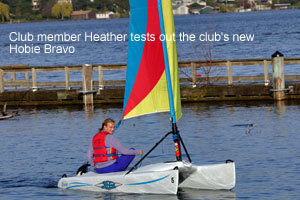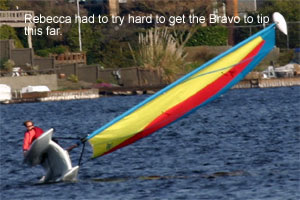 HOBIE
BRAVOS
HOBIE
BRAVOS HOBIE
BRAVOS
HOBIE
BRAVOSIn March of this year, the club purchased six Hobie Bravos for the instructional program. The Bravo is a 12' long, 22' tall, 4.5' wide roto-molded polyethylene boat. The Bravo has two hulls and a molded-in bridge deck/cockpit (with 4 cup holders and a semi-watertight storage compartment). There are no daggerboards as the Hobie Bravo has a low-aspect ratio keel designed to reduce lateral resistance while allowing for maneuverability. The rudder is the same type as what is on our catamarans; it will pop up when a certain amount of force is applied to the leading edge. The Bravo sail can be rolled around the mast with a pull on a line (roller furling), keeping sufficient shape to sail well with reduced sail area. There is a single, boomless (boom is optional), roller-furling/roller-reefing sail with semi-vertical battens. The mast is a two-part spar (aluminum extrusion with a fiberglass "comp tip" top section), with a Hobie Bob at the top to prevent the mast from sinking.
See http://www.hobiecat.com/sailing/models_bravo.html
for more information. 
The bylaws currently provide for two different types of ratings that allow someone to sail a Bravo. First, there is a "Bravo Rating", which allows one to sail in up to 7 knots in Union Bay. This rating requires a written test (either the Bravo Test or the Centerboard Novice Test) and a practical examination including capsize. This rating does not have higher levels - it is only a novice-level rating for Bravos only. Second, anyone possessing a Singlehanded rating may sail the Bravos in comparable winds and waters to what they may otherwise sail in. Anyone exercising this option should become familiar with rigging (above link, search for "Bravo Options" and click on 'boom') and capsize recovery (above link, search for "Righting Line and "Hobie Bob" Mast Float for Easy Righting") procedures BEFORE heading out on the water, as the Bravos are quite different from the Lasers.
Abigail Plawman and Randy Eakin